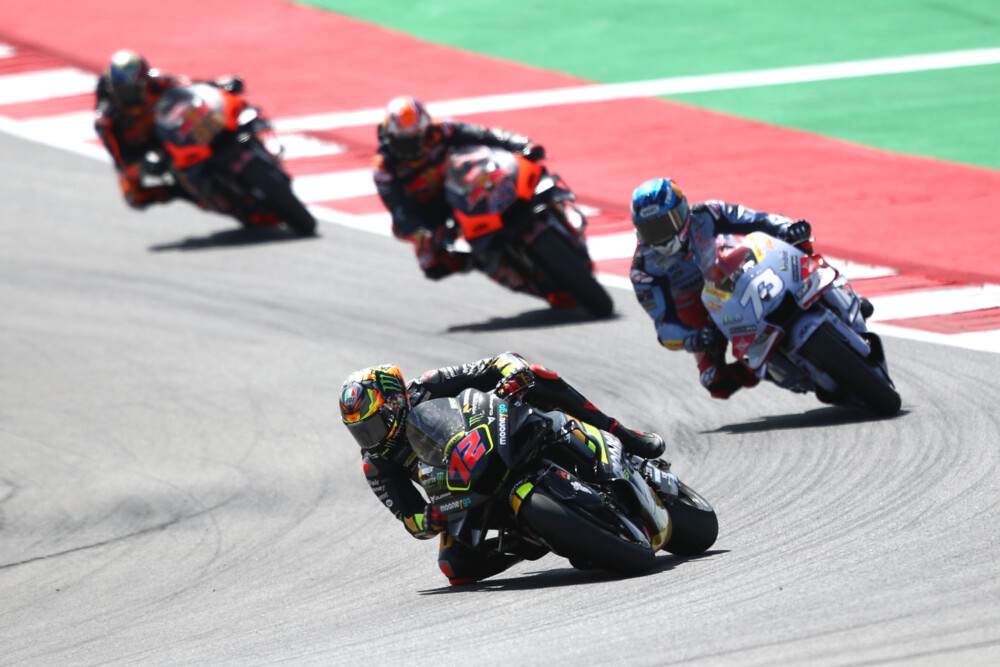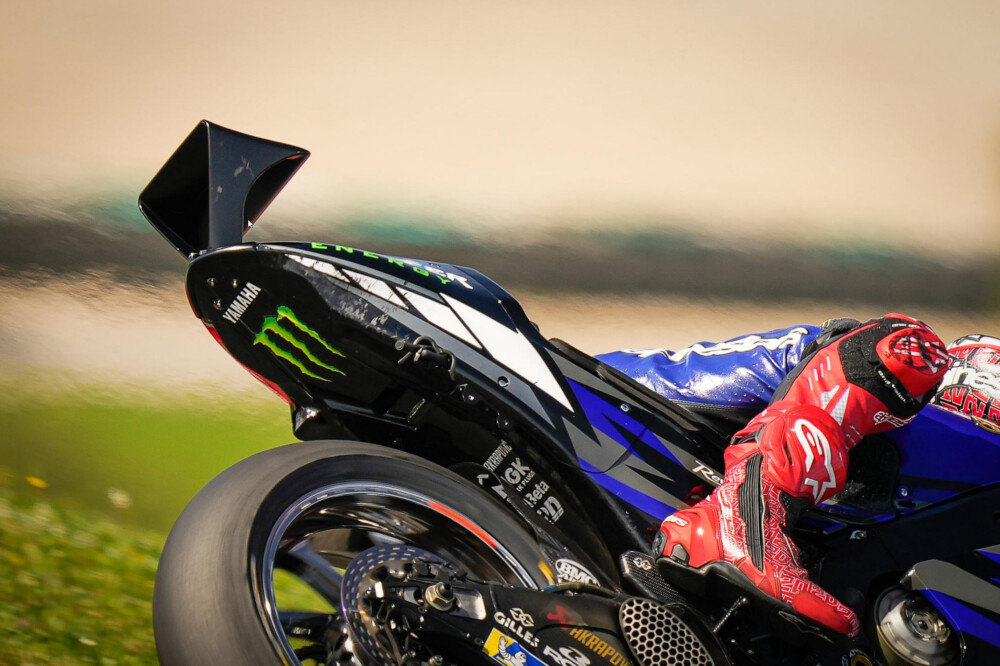Michael Scott | March 29, 2023
Cycle News In The Paddock
COLUMN
Wings and Things—Good, Bad and Ugly
Once upon a time, world championship racing’s great aerodynamic breakthrough was Geoff Duke’s skin-tight leather suit. In this way, the stylish double champion claimed an edge over rivals in their flapping high-drag two-piece suits.

A bit of an exaggeration. Only a year or two later, largely thanks to Moto-Guzzi’s cliff-side wind tunnel, came a new generation of handsome dustbin fairings, enclosing the front wheel.
Within three more years, these were banned on safety grounds. While properly developed bodywork, with a complementary rear enclosure, was a big step forward, flimsy garden-shed imitations were dubbed dangerous in crosswinds, and furthermore encouraged front (drum) brakes to overheat.
Now, almost seven decades later, some (including FIM president Jorge Viegas) are advocating a new ban on aerodynamics. For a variety of safety reasons—again including brake cooling.
Another is aesthetic.
Contemporary MotoGP bikes have so far departed from convention that even the most slavish showroom designer, turning racing trends into fashion, could hardly be rushing to imitate (for example) Yamaha’s absurd-looking inverted triangle on the back of the seat (seen at Portimao tests).

There is an argument against outlandish MotoGP developments. One of the sport’s appealing factors is (vaulting power and super-sticky tires apart) just how close the bikes are to top-end street-legal sportbikes. Then again, some might think the opposite—that looking different is an advantage.
There are more important questions about the several new dishes at the aero feast, the latest adding front-wheel side pods to seat-rear fins. It begins to feel like gluttony.
The origins of aero were simple enough: a search for more speed through less drag. The advent of double-size four-stroke engines and the enhanced efficiency of fuel injection and other electronics generated another factor: a need for better cooling.
Things started to go a little crazy in 2015, in innovative engineer Gigi Dall’Igna’s second year with Ducati. The first winglets on each side of the fairing nose and flanks introduced an element of downforce—combating wheelies so riders could use more of their surplus power for acceleration, and increasing the force on the front tire to allow harder braking.
As rivals copied Ducati, these appurtenances increased in size, number and sophistication, in spite of attempts by rule-makers to stem the tide. These were met with fresh innovation from Ducati, including 2019’s so-called “spoon” scoop under the front of the swingarm. This was nominally to provide a tire-cooling breeze, but also introduced some downforce at the rear. After protests by rivals failed, all the rest again copied Ducati.
By now costs were rising fast in tandem with the sophistication, with an increasing need for time in the wind-tunnel, and the start of recruitment of ex-F1 aerodynamicists—particularly from Ferrari by Ducati and fellow Italians Aprilia. A cost-saving rule allowing only one fairing update per season was a sticking plaster.
For there was more to come. By the end of 2021 Ducati was experimenting with “diffuser” ducting on the lower fairing flanks, reducing pressure there. The result, at high lean angles, was ground-effect, as another kind of downforce improving grip by adding weight without increasing mass.
In 2022 Aprilia had a different approach with the same effect—bulging fairing flanks that all-but scrape the road at full lean. Interestingly, Ducati experimented with something similar at pre-season tests this year, the first time they have copied anyone else.
But there was more. Fairing design might be restricted. Seats not so. And during last season both Aprilia (briefly) and Ducati (more permanently) added winglets to the rear. Ostensibly these add downforce to stabilize the rear under braking. Less obviously, they also further “dirty” the airflow in the bike’s wake, making slipstreaming even more difficult for following riders.
By the start of this year, all the rivals were at least experimenting with similar devices, including Yamaha’s inverted triangle.
One negative effect on the racing is difficulty in overtaking, not only because of problems slipstreaming, but also because the turbulent air behind a bike is less effective at cooling a follower’s front tire, already suffering extra stress because of the harder braking. Instead of keeping the pressure on, attacking riders must drop back to let their front tires recover somewhat.
At the same time, another exclusively MotoGP innovation further complicated the equation. Ride-height adjustment—dropping the rear—has the effect of reducing the angle of attack of the wings, cutting drag for more top speed. Conversely, it allows a greater angle of attack for more downforce under braking when the rear is released to normal ride height.
How relevant is this to street riders? Actually, not at all. Race engineering is now too sophisticated to expect racing to improve the breed. We could however expect it to inform the breed.
But what’s the point, if that information is simply irrelevant? CN
Click here for all the latest MotoGP news.